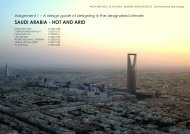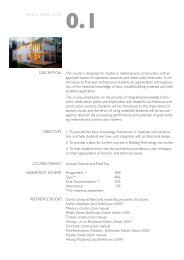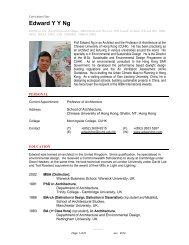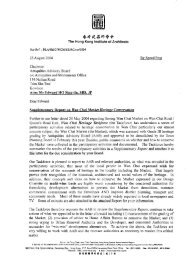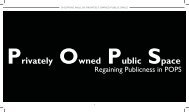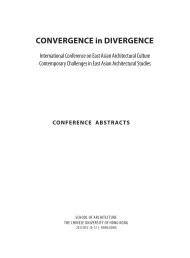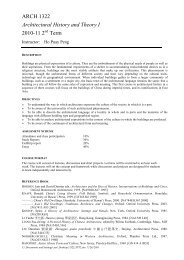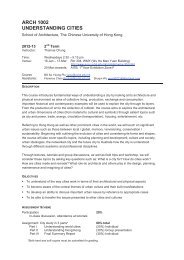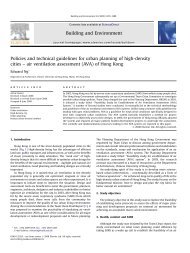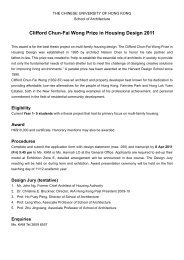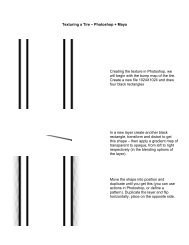Black Book - School of Architecture - The Chinese University of ...
Black Book - School of Architecture - The Chinese University of ...
Black Book - School of Architecture - The Chinese University of ...
- No tags were found...
You also want an ePaper? Increase the reach of your titles
YUMPU automatically turns print PDFs into web optimized ePapers that Google loves.
Studio U5place | contextDESIGN STUDIO Place Making and Contextual Response arch 3110leng woo / thomas chung / allen poon / tc yuet<strong>The</strong> idea <strong>of</strong> relating a building to its context represents a basic understanding in designingarchitecture on a site, and in the company <strong>of</strong> other buildings. At the level <strong>of</strong> building, itexploits the unique quality <strong>of</strong> a site, informs the placement <strong>of</strong> building, and shapes the insideoutsiderelationship. At the contextual level, it considers architecture as a part <strong>of</strong> the city, andcontributes to the making <strong>of</strong> public places.22In traditional societies, this architectural response is obvious- a house forming a part <strong>of</strong> avillage, several houses forming a village square, and a village fitting seamlessly into the rural23context. With increasing demand for individuality, larger scale <strong>of</strong> cities, and rapid urbanization,this fundamental requirement <strong>of</strong> architecture is <strong>of</strong>ten ignored. Contextual design is sometimesargued to be <strong>of</strong> lesser importance given the vast scale, and internal concerns <strong>of</strong> architecturetoday. Yet the making <strong>of</strong> connectivity, openness, and publicness in architecture is ever morepressing in the contemporary city, for it alleviates isolation, fosters tolerance, and givespleasure and meaning to places.Luigi SnozziThis studio investigates contextual response and place making in architecture. Using theNew Territories as a context, the studio searches for the design <strong>of</strong> building and space so asto respond to: 1) the disintegration <strong>of</strong> urban fabric; 2) the ineffective use <strong>of</strong> space; and 3) thelack <strong>of</strong> a coherent urban strategic plan. Behind the studio is an attempt to use architectureas a tool to explore alternative urban strategies to the current architectural and planningpractices in Hong Kong.wong kei fung cathyabove: lee yiu ming julius ; below: cheung kwai yin dellaabove: cheung kwai yin della; below: tsoi yun fung avaACTIVITYREQUIRED COURSELand and Cityarch 3310 leng wooThis course is an introduction to the form <strong>of</strong> cities,and includes a series <strong>of</strong> lectures to examine theform and process <strong>of</strong> cities. What are the differentforms <strong>of</strong> city? What are their physical attributes?What shape cities? <strong>The</strong>se are questions that willbe addressed. Through the study <strong>of</strong> urban formand fabric in history, the course will examine theurban process. Students will study selected parts<strong>of</strong> Hong Kong, and develop a theoretical viewabout land and city.Building Systems Integrationarch 3411 ks wong / raymond yauThis course consolidates fundamentals established inarch 1411, arch 1420, arch 2411 & arch 2420 throughan integrative consideration <strong>of</strong> building technology inthe design and construction <strong>of</strong> buildings. It exploresthe integration <strong>of</strong> structure, envelope, buildingservices, interior and environmental considerations inarchitectural design, and how systems are coordinatedthrough a multi-disciplinary approach. Case studieswill illustrate concept and practice, and the value <strong>of</strong>integration for sustainability in design.Design Computationbuilding information modellingStudents establish overarching design rules anddependencies to understand relationships betweenentities that form larger clusters. Building InformationModelling forms the basis for this exploration.ELECTIVEPainting toward<strong>Architecture</strong> Part Iarch 4501a gu daqing<strong>The</strong> course investigates the method<strong>of</strong> space organization in both paintingand architecture. It concerns issuesas listed: perspective as illusion,simultaneous representation, change<strong>of</strong> focus from deep to flat space,spatial organization in paintings todevelopment <strong>of</strong> spatial perception.China Urban Housingarch 4701 tsou jin-yeuTo enrich understanding to thehistory and current situation <strong>of</strong>China Urban Housing, the courseprovides the opportunity to researchon interaction between the builtenvironment and society in China.Students can research on topics suchas housing characteristics in China,the contemporary <strong>Chinese</strong> societystructure, subsidized housing fordisadvantaged groups.Urban Infrastructure <strong>of</strong>Hong Kongarch 4801 bruce lonnmanThis course examines the design andaesthetics <strong>of</strong> movement infrastructurein the form <strong>of</strong> bridges, tunnels, roads,pedestrian walks, and other structuresrelated to circulation in the city. Focusis on the context <strong>of</strong> Hong Kong withreference to precedents worldwide.<strong>The</strong> content <strong>of</strong> the course material willderive primarily from documentationand discussion <strong>of</strong> local case studies.Digital <strong>Architecture</strong>sarch 4901 marc aurel schnabel<strong>The</strong> aim <strong>of</strong> this course is forstudents to become eloquent inusing parametric architectural designtechniques. Students shall exploreideas, analyze data, present andcommunicate design conceptselectronically by exploring a variety<strong>of</strong> parameters <strong>of</strong> their design.Students will gain a broad knowledge<strong>of</strong> architectural design computinginstruments and techniques.



